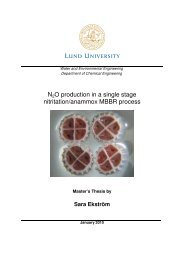Alexander Szabo and Oscar Engle - Svenskt Vatten
Alexander Szabo and Oscar Engle - Svenskt Vatten
Alexander Szabo and Oscar Engle - Svenskt Vatten
Create successful ePaper yourself
Turn your PDF publications into a flip-book with our unique Google optimized e-Paper software.
treatment facilities simple, treatment ponds or Imhoff tanks were usually implemented. The idea<br />
was that after one year of utilization, the responsibility for running <strong>and</strong> maintaining the treatment<br />
facilities was transferred to the municipal authorities. However, not every local authority had the<br />
resources to run the centralized treatment facilities <strong>and</strong> as a result centralized treatment systems<br />
grew only from 3.5% in 1970 to 5% in 1990. This can be compared to septic tanks coverage in<br />
urban areas which grew from 17.2% in 1970 to 37.3% in 1990 (Ujang & Henze, 2006).<br />
In 1993 a new law, the Sewage Service Act, was implemented <strong>and</strong> a new Federal agency, the<br />
Sewage Service Department was established. The main task of the new agency was to plan,<br />
regulate <strong>and</strong> control sewage water treatment. Since 1993 the agency has been responsible for the<br />
national privatization project <strong>and</strong> in 1993 Indah Water Konsortium (IWK) was given the task to<br />
operate <strong>and</strong> maintain existing treatment facilities (Ujang & Henze, 2006). The reason for<br />
privatizing was to assist the Sewage Service Department with maintenance of existing sewage<br />
systems, refurbishment of old systems <strong>and</strong> constructions of new sewage systems in urban areas<br />
(Ujang & Henze, 2006).<br />
At the moment there are two st<strong>and</strong>ards for treated waste water quality, according to the<br />
Environmental Quality Act from 1974. Every treatment system must comply with either st<strong>and</strong>ard<br />
A or st<strong>and</strong>ard B. St<strong>and</strong>ard A is used if the water is discharged upstream of any raw water intake<br />
<strong>and</strong> St<strong>and</strong>ard B is used when water is discharged downstream of a raw water intake (Sewerage<br />
Services Department, 1998). The most important parameters of treated waste water to be<br />
followed are Biochemical Oxygen Dem<strong>and</strong> over a period of 5 days (BOD 5 ) <strong>and</strong> total suspended<br />
solids (TSS). No discharge of treated waste water higher than the absolute values are permitted by<br />
the law. Because of fluctuations in the quality of the treated waste water, the effluent waste water<br />
quality should be designed to reach a lower “design” value (Table 1.1). This is to ensure that the<br />
effluent waste water quality never reach above the absolute values. The permitted limits for<br />
St<strong>and</strong>ard A <strong>and</strong> St<strong>and</strong>ard B can be seen in Table 1.1 below.<br />
Table 1.1: Malaysian Design values for BOD 5 <strong>and</strong> TSS for treated effluent waste water quality. (redrawn<br />
from Sewerage Services Department, 1998)<br />
Parameter St<strong>and</strong>ard A St<strong>and</strong>ard B<br />
Absolute Design Absolute Design<br />
BOD 5 (mg/l)<br />
TSS 2 (mg/l)<br />
20 10<br />
50 20<br />
50 20<br />
100 40<br />
During the project the effluent st<strong>and</strong>ard from 1974 was changed. It came to our knowledge after<br />
all the sampling from the pond was done that a new st<strong>and</strong>ard was introduced in December 2009.<br />
The new st<strong>and</strong>ard is similar to the one of 1974. The permitted limits for BOD 5 <strong>and</strong> TSS levels are<br />
unchanged. The main difference is the introduction of nitrogen <strong>and</strong> phosphorous removal<br />
(Department of Environment, 2009). Because no measurements of nitrogen <strong>and</strong> phosphorous was<br />
not done we will mostly use St<strong>and</strong>ard A <strong>and</strong> St<strong>and</strong>ard B from 1974 throughout the report. For<br />
more information about the new effluent st<strong>and</strong>ard see Table C.1 in Appendix C.<br />
<br />
13















